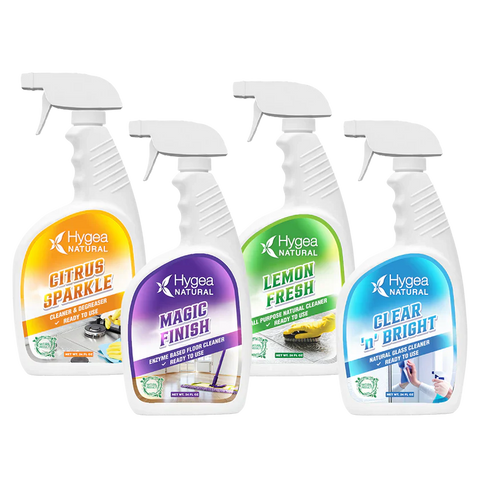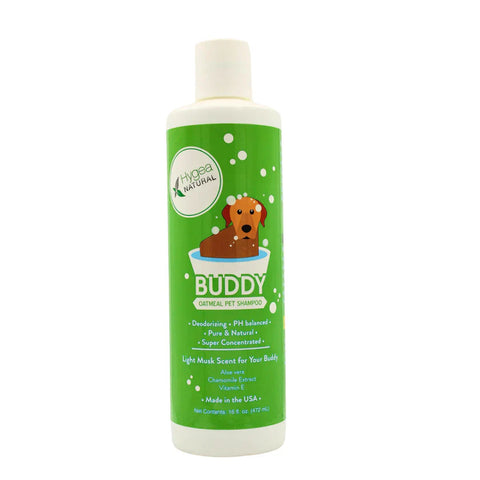Cleaning is meant to keep our homes health. But, have you thought about what’s lurking inside your favorite sprays and scrubs?
Many common cleaning products contain harsh chemicals that may do more harm than good, putting your well-being at risk every time you mop, wipe, or disinfect.
But protecting your loved ones doesn’t mean giving up a sparkling home.
This guide reveals hidden dangers in the cleaning aisle, the health problems they can cause, and how switching to non-toxic cleaning products from brands like Hygea Natural can make a real difference.
Why Your Cleaning Routine Might Be Doing More Harm Than Good
Step into almost any grocery store, and you’ll find shelves packed with cleaning solutions promising a spotless, germ-free home. What those labels don’t always tell you is just how toxic some of these products can be.
Even well-known brands often use ingredients that the Environmental Working Group (EWG) and consumer safety organizations link to health issues.
According to a survey by the American Lung Association, many cleaning supplies release substances that can trigger asthma, skin irritation, or even more severe conditions.
Whether it’s the all-purpose cleaner under your sink or the “fresh scent” laundry additive in the cupboard, millions unknowingly bring potential hazards home.
Are sparkling countertops worth the health trade-off? Understanding the risks is the first step to creating a healthier home environment.
The Health Risks Hiding in Your Cleaning Cabinet
While most people believe cleaning makes their homes safer, the wrong choice of products can introduce dangerous chemicals that contribute to health issues such as:
Breathing Problems
Many cleaning agents release volatile organic compounds (VOCs) that become airborne with every spray. Breathing in these chemicals—even in small doses and especially in poorly ventilated spaces—can lead to:
- Coughing and throat irritation
- Shortness of breath
- Asthma attacks and worsening symptoms for those with respiratory conditions
Research published in the journal Thorax even links prolonged exposure to certain cleaning chemicals with increased rates of chronic respiratory conditions and decreased lung function.
Skin and Eye Irritation
Direct contact with some cleaning products can cause redness, rashes, or even burns. Aerosol sprays, bleach, and ammonia-based cleaners are notorious culprits, often leaving sensitive skin feeling dry, itchy, or inflamed.
Headaches and Dizziness
Strong chemical scents don’t just make your home “smell clean”—they can trigger headaches, dizziness, and even nausea. Fragrances and artificial scents often contain phthalates, which, besides being irritating, may disrupt hormone balance.
Long-Term Health Effects
Prolonged exposure to certain chemicals found in conventional cleaners is associated with much more than irritation:
- Hormonal disruption (linked to phthalates and parabens)
- Increased risk of some cancers (linked to formaldehyde, a common preservative)
- Potential developmental issues in children (from persistent exposure)
With growing evidence pointing to the risks, more households are seeking healthier cleaning habits.
The Most Dangerous Cleaning Chemicals to Avoid
Reading ingredient lists isn’t always simple, but knowing what to watch out for can help you avoid the worst offenders. Here are key chemicals you should steer clear of:
Ammonia: Found in glass and stainless-steel cleaners, ammonia causes irritation to the eyes and lungs. High concentration exposure can lead to respiratory distress and burns.
Chlorine Bleach: A favorite for whitening laundry and disinfecting, but bleach releases toxic fumes that are especially harmful when mixed with other cleaners. Chronic exposure can damage skin and the respiratory tract.
Phthalates: Often listed as “fragrance,” these chemicals are used to prolong scents and are linked to hormone disruptions and potential developmental effects.
Triclosan: Still present in some antibacterial sprays and liquid soaps, triclosan can disrupt hormones and may contribute to antibiotic resistance.
2-Butoxyethanol: This powerful solvent hides in window and multipurpose cleaners, yet can cause sore throats, kidney and liver damage with prolonged exposure.
Quaternary Ammonium Compounds (Quats): Used for their disinfectant power, "quats" can trigger skin rashes and respiratory problems, particularly in people with asthma.
Formaldehyde: Used as a preservative and sometimes released by chemical reactions in cleaning products, this known carcinogen is best kept far from your home.
If you’re struggling to spot these ingredients, look for signal words like “danger,” “warning,” or “caution,” which are legally required on labels containing hazardous substances.
Hygea Natural Leading the Way in Non-Toxic Cleaning
Hygea Natural sets itself apart for households looking for non-toxic cleaning products backed by research and transparency. The brand’s philosophy is simple: deliver the power to clean without the harsh chemicals found in most major cleaning brands.
What Makes Hygea Natural Different
- Only non-toxic ingredients with a strong track record of safety in residential, commercial, and hospitality environments
- No artificial dyes, fragrances, or harmful preservatives
- Safe for use around children and pets, making it a top pick for sensitive households
- Recyclable packaging and cruelty-free processes that align with responsible home care
Every Hygea Natural product is rigorously tested and developed by industry experts. Their promise? Results that don’t make you choose between safety and cleanliness.
Popular Non-Toxic Picks From Hygea Natural
- Non Toxic Cleaning Starter Kit
- Lemon Fresh Multi-Surface and Floor Cleaning Spray
- EasyBreeze All Purpose Cleaning Wipes
- Spotless Essentials 2-in-1 Cleaner & Pest Treatment
Switching to Safer Cleaning Habits
Making the transition to safer cleaning is easier than you might think. Here’s how to get started:
Audit What’s Under Your Sink: Start by reading ingredient labels and making a list of all your current products, identifying those with hazardous substances.
Use Up or Dispose Responsibly: Don’t rush to throw everything out. Use up what you have if safety allows, then recycle containers or follow local hazardous waste disposal guidelines.
Stock Up on Safer Basics: Replace old staples with safer options. Look for third-party certifications and clear ingredient lists, or start your switch with an all-in-one non-toxic kit like Hygea Natural’s Cleaning Starter Kit.
Build New Habits: Open windows for better ventilation, wear gloves when cleaning, and keep all products (even safe ones) out of children’s reach.
A Healthier Home Starts With Informed Choices
Choosing what’s best for your family isn’t just about shiny surfaces. It’s about ensuring your living space helps—not harms—your health.
By understanding hidden dangers in conventional products, avoiding toxic chemicals, and opting for non-toxic alternatives like Hygea Natural, you invest in a truly cleaner, safer home.
Want to experience a safer, cleaner home with confidence? Save 10% on your next order with code HYGEAFAMILY or get 15% off your first purchase by signing up for the Hygea Natural newsletter.
Explore the entire range of non-toxic cleaning products at Hygea Natural and find the safer swap that’s right for you.




